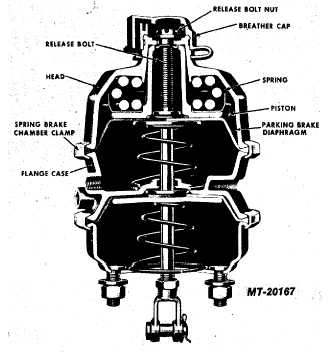|
| |
TM 5-4210-230-14&P-1
VEHICLE OPERATION
BRAKE RELEASE (Parking)
MGM SPRING BRAKE
To release the spring brake (manual release) in the
event there is loss of air and the vehicle must be towed, the
spring brake must be manually released or “caged”.
Cross Section of MGM Spring Brake Assembly
If the release bolt should bind, apply "Liquid Wrench"
or equivalent to the bolt and allow to soak into the threads.
In the event the air source has been depleted the
release bolt can be backed off by removing the breather cap
and turning the release bolt counterclockwise 57.15 to 63.5
mm (2 1/4" to 2 1/2") or approximately 30 turns. When
turning the bolt you will actually be pulling or collapsing the
spring manually.
BRAKE RESET (Anchor Lok)
Charge spring brake chambers with air pressure.
Remove the release stud and nut from the spring housing and
reinstall the access plug in the housing opening. Reinstall the
release stud and nut in the carrying pocket on the brake
chamber housing.
BRAKE RESET (MGM)
If the release bolt threads are dry apply a light coat of
"Never Seeze" lubricant or equivalent to the threads. Do not
apply "Never Seeze" lubricant supplied in an aerosol can.
To manually reset parking brake at each spring brake
chamber, screw release bolt down into unit until nut is
bottomed against the receiver. Torque nut to 67.79 N.m (50
ft.lbs.) and reinstall breather caps.
BRAKES (Hydraulic)
CAUTION
Hydraulic brake systems used on S-Series
models
are
power
assisted.
Braking
capabilities will be greatly reduced without
engine assist. DO NOT MOVE VEHICLE
WITH DEAD ENGINE.
If a failure is experienced in one side of the split
hydraulic system, the vehicle will still have the remaining
portion of the split system to allow stopping the vehicle;
however, the vehicle should be operated only with extreme
caution to reach a repair facility since the braking capabilities
will be reduced.
BRAKE PEDAL
Should the brake become wet, immediately dry them
while the vehicle is moving by light application of the brake
pedal.
PARKING BRAKE (Burnishing)
Refer to Maintenance Section.
CLUTCH PEDAL
Do not ride the clutch pedal. Keep your foot off the
clutch pedal except to shift gears or when the truck is being
brought to a stop.
DRIVING (Manual Transmission)
1.
Always check the brake system by depressing the
brake pedal before attempting to drive the vehicle. This
will familiarize you with the brake pedal action.
Observe the air gauges to determine if the minimum of
483 kPa (70 psi) pressure exists.
2.
Depress the clutch pedal.
3.
Shift the transmission into first gear position.
4.
Release the parking brake.
5.
Depress the accelerator pedal to speed up the engine
sufficiently to pick up the load. Release the clutch
pedal slowly and further depress the accelerator pedal
to prevent the engine from stalling while the vehicle
moves forward.
6.
As the speed increases, release the accelerator and at
the same time depress the clutch pedal. Then shift the
transmission to the next higher transmission gear.
Release the clutch slowly and depress the accelerator
as described above. Repeat this procedure as you shift
progressively into the higher speed ranges.
DRIVING DOWNHILL
A safety rule followed by all experienced drivers when
driving downhill, is to use the brakes and transmission gear
combinations to keep the vehicle under control. Before
entering the downhill grade, apply the brakes to
3
|


